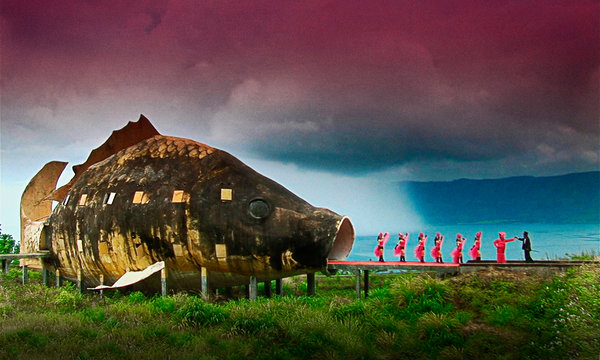Movie review by Greg Carlson
Filmmaker Joshua Oppenheimer, working with co-directors Christine Cynn and an anonymous Indonesian who, like so many other of the unnamed collaborators listed in the credits, elected to withhold identity out of personal fear, labored for half a decade on the brutal and brilliant “The Act of Killing.” A singular non-fiction that Oppenheimer has described as a “documentary of the imagination,” the movie addresses the mid-1960s genocide of an alleged million victims, including communists, intellectuals, and ethnic Chinese living in Indonesia, through the eyes of the death squad executioners who carried out the murders firsthand.
Applying the controversial conceit of working with the killers to reconstruct their atrocities as re-imagined movie scenes done in candy-colored genre styles including musicals, Westerns, and gangster pictures, Oppenheimer arrives at a surreal crossroads of truth and memory. In a terrific interview with Pamela Cohn, the filmmaker defended the unorthodox approach, saying “[The] thought was to look not only at the characters, but the whole regime, through a prism where we see the stories and are also able to create the second- and third-hand stories in which they imagine themselves – and fail to know themselves.”
While the film introduces a ghoulish gallery of seemingly soulless thugs, a grandfather named Anwar Congo soon emerges as the movie’s central character. Attended to by the flamboyant, younger, paramilitary-affiliated Herman Koto, Congo surprises the viewer via his weird identification with the people he put to death nearly fifty years ago, even electing to appear as the condemned in some of the movie-in-the-movie productions. In scene after astonishing scene, Congo discusses his methods and techniques in the very places where he took away lives, at one point demonstrating the effectiveness of asphyxiation by garrote and its superiority to beheading.
A number of critics have complained that “The Act of Killing” fails by omitting or ignoring the deceased in favor of their assassins (Oppenheimer is working on another film that follows family members of a victim), but I think the casualties reside in each and every frame, from the heartbreaking anecdote told by a man whose stepfather was dragged from bed in the middle of the night to Congo’s final interaction with Oppenheimer. As the story unfolds, the viewer can begin to experience a sense of profound intellectual and emotional dysphoria, wondering when, or even if, Congo will recognize the magnitude of his transgressions. Oppenheimer’s visual answer does not disappoint, and the hallucinatory conclusion of “The Act of Killing” results in cinema’s most accomplished ending of 2013.
What then should we make of our brief, and hopefully only, acquaintance with Anwar Congo? At the risk of sounding like one of those “shallow thinkers attempting to seem intellectually sophisticated” described by Ron Rosenbaum in his 2009 essay on Hannah Arendt’s famous construction “the banality of evil,” I could not help but be astonished by the layers of Anwar’s psychic armor and the depths of his denial. Rosenbaum, citing scholar Bernard Wasserstein, mentions Arendt’s original concept of “radical evil” and the irreconcilable contradiction between “radical” and “banal” as descriptors. In “The Act of Killing,” Oppenheimer gets as close as anyone to bringing those poles into proximity.
